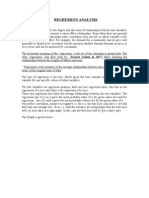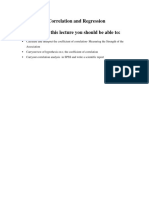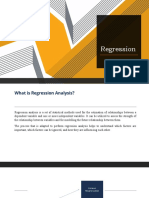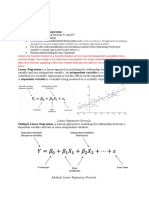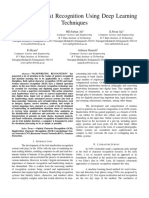0 ratings0% found this document useful (0 votes)
17 viewsLinear Regression
Uploaded by
Varun VarunCopyright
© © All Rights Reserved
Available Formats
Download as PPTX, PDF, TXT or read online on Scribd
0 ratings0% found this document useful (0 votes)
17 viewsLinear Regression
Uploaded by
Varun VarunCopyright
© © All Rights Reserved
Available Formats
Download as PPTX, PDF, TXT or read online on Scribd
You are on page 1/ 12
LINEAR REGRESSION
19ME16N-FUNDAMENTAL OF MACHINE LEARNING
DEFINITION
• Linear regression is perhaps one of the most well known and well understood
algorithms in statistics and machine learning.
• In statistics,
linear regression is a linear approach for modelling the
relationship between a scalar response and one or more explanatory variables
(also known as dependent and independent variables).
• The case of one explanatory variable is called simple linear regression; for
more than one, the process is called multiple linear regression.
• In linear regression, the relationships are modeled using
linear predictor functions whose unknown model parameters are estimated
from the data. Such models are called linear models.
Linear regression has many practical uses. Most applications fall into one of the
following two broad categories:
If the goal is prediction, forecasting, or error reduction, linear regression can
be used to fit a predictive model to an observed data set of values of the
response and explanatory variables. After developing such a model, if
additional values of the explanatory variables are collected without an
accompanying response value, the fitted model can be used to make a
prediction of the response.
If the goal is to explain variation in the response variable that can be attributed
to variation in the explanatory variables, linear regression analysis can be
applied to quantify the strength of the relationship between the response and
the explanatory variables, and in particular to determine whether some
explanatory variables may have no linear relationship with the response at all,
or to identify which subsets of explanatory variables may contain redundant
information about the response.
TYPES OF LINEAR REGRESSION:
Univariate LR:
• Linear relationships between y and X variables can be explained by a
single X variable
• y=a+bX+ϵ
Where, a = y-intercept, b = slope of the regression line (unbiased estimate)
and ϵ = error term (residuals)
Multiple LR:
• Linear relationships between y and X variables can be explained by
multiple X variables
• y=a+b1X1+b2X2+b3X3+...+bnXn+ϵ
Where, a = y-intercept, b = slope of the regression line (unbiased estimate)
and ϵ = error term (residuals)
• The y-intercept (a) is a constant and slope (b) of the regression line is a
regression coefficient.
LINEAR REGRESSION (LR)
ASSUMPTIONS
• The relationship between the X and y variables should be linear
• Errors (residuals) should be independent of each other
• Errors (residuals) should be normally distributed with a mean of 0
• Errors (residuals) should have equal variance
LINEAR REGRESSION (LR) OUTPUTS
Correlation coefficient (r)
• Correlation coefficient (r) describes a linear relationship
between X and y variables. r can range from -1 to 1.
• r > 0 indicates a positive linear relationship between X and y variables. As one
of the variable increases, the other variable also increases. r = 1 is a perfect
positive linear relationship
• Similarly, r < 0 indicates a negative linear relationship
between X and y variables. As one of the variable increases, the other
variable decreases, and vice versa. r = -1 is perfect negative linear relationship
• r = 0 indicates, there is no linear relationship between the X and y variables
Coefficient of determination (R-Squared or r-Squared)
R-Squared (R2) is a square of correlation coefficient (r) and usually
represented as percentages.
R-Squared explains the variation in the y variable that is explained
by independent variables in the fitted regression.
Multiple correlation coefficient (R), which is the square root of the
R-Squared, is used to assess the prediction quality of the y variable
in multiple regression analysis. Its value range from 0 to 1.
R-Squared can range from 0 to 1 (0 to 100%). R-squared = 1
(100%) indicates that the fitted regression line explains all the
variability of Y variable around its mean.
From this plot, it is clear that there is a strong linear relationship between these two
features: as SIZE increases so too does RENTAL PRICES by a similar amount.
If we could capture this relationship in a model, we would be able to do two
important things.
First, we would be able to understand how office size affects office rental price.
Second, we would be able to fill in the gaps in the dataset to predict office rental
prices for office sizes that we have never actually seen in the historical data
t the equation of a line can be written as y=mx+c where m is the slope of the line,
and b is known as the y-intercept of the line (i.e., the position at which the line meets
the vertical axis when the value of x is set to zero).
The equation of a line predicts a y value for every x value given the slope and the y-
intercept, and we can use this simple model to capture the relationship between two
features such as SIZE and RENTAL PRICE.
It shows the same scatter plot as shown with a simple linear model added to capture
the relationship between office sizes and office rental prices.
This model is Rental price = 6.47+(0.62*Size)
You might also like
- Regression Analysis in Machine LearningNo ratings yetRegression Analysis in Machine Learning13 pages
- Ch 4- Correlation and Regression YARA&LAMANo ratings yetCh 4- Correlation and Regression YARA&LAMA27 pages
- Introducing Regression: Notes Unit 5: Regression BasicsNo ratings yetIntroducing Regression: Notes Unit 5: Regression Basics5 pages
- 8.1-linear-regression-and-correlation-analysis-glossaryNo ratings yet8.1-linear-regression-and-correlation-analysis-glossary8 pages
- Linear Regression - Six Sigma Study GuideNo ratings yetLinear Regression - Six Sigma Study Guide17 pages
- Linear - Regression & Evaluation MetricsNo ratings yetLinear - Regression & Evaluation Metrics31 pages
- simple linear regression with example problemNo ratings yetsimple linear regression with example problem12 pages
- Direct Linear Transformation: Practical Applications and Techniques in Computer VisionFrom EverandDirect Linear Transformation: Practical Applications and Techniques in Computer VisionNo ratings yet
- Jedox Ebook Ultimate Guide Scenario Planning enNo ratings yetJedox Ebook Ultimate Guide Scenario Planning en13 pages
- A Higher-Level Security Scheme For Key Access On Cloud ComputingNo ratings yetA Higher-Level Security Scheme For Key Access On Cloud Computing6 pages
- Introduction to Econometrics 3rd Edition James H. Stockpdf download100% (1)Introduction to Econometrics 3rd Edition James H. Stockpdf download50 pages
- 4-6-normal-distributions-003eCoyDOpsVHlU3No ratings yet4-6-normal-distributions-003eCoyDOpsVHlU339 pages
- Analysis of Algorithms - Set 5 (Practice Problems)No ratings yetAnalysis of Algorithms - Set 5 (Practice Problems)8 pages
- 2.05 Application of Matrices in Cryptography0% (1)2.05 Application of Matrices in Cryptography4 pages
- Serpent and Smartcards: Abstract. We Proposed A New Block Cipher, Serpent, As A Candidate ForNo ratings yetSerpent and Smartcards: Abstract. We Proposed A New Block Cipher, Serpent, As A Candidate For8 pages
- Risk-Sensitive Prescriptive Analytics: Real Estate Case StudyNo ratings yetRisk-Sensitive Prescriptive Analytics: Real Estate Case Study5 pages
- Introducing Regression: Notes Unit 5: Regression BasicsIntroducing Regression: Notes Unit 5: Regression Basics
- 8.1-linear-regression-and-correlation-analysis-glossary8.1-linear-regression-and-correlation-analysis-glossary
- Correlation and Regression: Six Sigma Thinking, #8From EverandCorrelation and Regression: Six Sigma Thinking, #8
- Direct Linear Transformation: Practical Applications and Techniques in Computer VisionFrom EverandDirect Linear Transformation: Practical Applications and Techniques in Computer Vision
- A Higher-Level Security Scheme For Key Access On Cloud ComputingA Higher-Level Security Scheme For Key Access On Cloud Computing
- Introduction to Econometrics 3rd Edition James H. Stockpdf downloadIntroduction to Econometrics 3rd Edition James H. Stockpdf download
- Analysis of Algorithms - Set 5 (Practice Problems)Analysis of Algorithms - Set 5 (Practice Problems)
- Serpent and Smartcards: Abstract. We Proposed A New Block Cipher, Serpent, As A Candidate ForSerpent and Smartcards: Abstract. We Proposed A New Block Cipher, Serpent, As A Candidate For
- Risk-Sensitive Prescriptive Analytics: Real Estate Case StudyRisk-Sensitive Prescriptive Analytics: Real Estate Case Study

